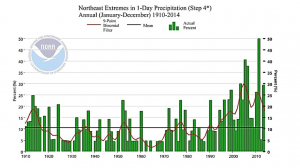By Anjeli Smith
Why Montgomery County Residents Should Care About Climate Change
By Anjeli Smith, Walt Whitman High School
Some of the most prominent effects of climate change that Montgomery County will face are less-predictable: more severe weather patterns and the ripple effects caused by them, including flash-floods, damage to infrastructure, heat waves, and an increase in rain, snow, and thunderstorms. In fact, it is predicted that the D.C. area will feel like Mississippi in about 60 years. According to a professor at the University of Maryland Center for Environmental Science, “subtropical climates from the Deep South could be in store for the DMV within a generation” (Paz, 2019).
As climate change causes increased global temperatures, humidity increases as well. A seemingly insignificant rise in atmospheric temperature creates a snowball effect, leading to higher humidity, more severe and more frequent thunderstorms, more dangerous flooding, therefore damaging infrastructure. According to the University of Maryland College of Agriculture and Natural Resources website, “When air temperature increases, more water vapor can be held in the air. Combined with the extra energy available to storms that arise over the warming ocean, the additional water vapor in the air causes more rainfall and increasingly severe winds” (“Climate change impacts”). We’ve experienced hotter, more humid summers the past several years, as well as more frequent afternoon storms. This is not just a coincidence; it is caused largely by climate change (see graph below).
(“Climate change impacts”)
This past July, D.C. experienced its first-ever flash flood warning; the National Weather Service reserves these for only “life-threatening” and “particularly dangerous” situations (Samenow, Livingston, & Halverson, 2019). It was D.C.’s “seventh-wettest July day on record (since 1871)”, and was so sudden and rare that “the odds of rain this intense in any given year are less than 1 percent” (Samenow, Livingston, & Halverson, 2019). This event affected areas all over the DMV, including Montgomery County, stranding people in their cars, forming massive sinkholes, and even flooding a Virginia Metro station.
A Maryland state government website states that Maryland residents will experience “increased risk of flooding and significant property damage as a result of more precipitation and extreme weather events. Children, the elderly, and other sensitive populations are vulnerable to the effects of heat waves and increased air pollution” (“Climate change Maryland”). If we don’t act now, we will continue to see more and more people in Montgomery County negatively affected by climate change, even within the next decade.
(Dildine, 2019)
 Montgomery County declared a climate emergency in 2017, aiming to accelerate “our community-wide climate goals to be carbon neutral by 2035” (Smith-Schoenwalder, 2019). However, many climate activists from Takoma Park Mobilization recently arranged a “climate emergency” town hall meeting, doubtful that the county has actually accomplished anything to reach their goal since 2017 (Kazanjian, 2019). County officials maintained that they supported the cause, but recommended that the audience, primarily youth climate activists, create change instead. County Executive Marc Elrich urged, “We need you all to create a movement” and said that change doesn’t come from county executives. To show their effort, they cited an attempt to transition Montgomery County buses to an electric bus pilot program, but said that they faced reluctance from County schools. The climate change coordinator for Montgomery County, Adriana Hochberg, said that future legislation would include “creating a task force to study building energy performance standards”. Elrich also mentioned future legislation would “require all new houses and townhouses by a certain date to have solar roofs”. Although the county government has many goals set for reaching carbon neutrality by 2035, “Climate groups in the county have given the government a score of 32 out of 100 for inaction on this issue so far,” stated keynote speaker and climate scientist Danielle Meitiv.
Montgomery County declared a climate emergency in 2017, aiming to accelerate “our community-wide climate goals to be carbon neutral by 2035” (Smith-Schoenwalder, 2019). However, many climate activists from Takoma Park Mobilization recently arranged a “climate emergency” town hall meeting, doubtful that the county has actually accomplished anything to reach their goal since 2017 (Kazanjian, 2019). County officials maintained that they supported the cause, but recommended that the audience, primarily youth climate activists, create change instead. County Executive Marc Elrich urged, “We need you all to create a movement” and said that change doesn’t come from county executives. To show their effort, they cited an attempt to transition Montgomery County buses to an electric bus pilot program, but said that they faced reluctance from County schools. The climate change coordinator for Montgomery County, Adriana Hochberg, said that future legislation would include “creating a task force to study building energy performance standards”. Elrich also mentioned future legislation would “require all new houses and townhouses by a certain date to have solar roofs”. Although the county government has many goals set for reaching carbon neutrality by 2035, “Climate groups in the county have given the government a score of 32 out of 100 for inaction on this issue so far,” stated keynote speaker and climate scientist Danielle Meitiv.
(“Climate change Maryland”)
Although Montgomery County was one of the first jurisdictions in the country to declare a climate emergency, no one is immune to the effects of climate change. According to the UN Intergovernmental Panel on Climate Change (IPCC) report that lays out the effects of global warming of 1.5 °C, we only have until 2030 to limit climate change before it’s too late. Although there is no clear or single solution as to how we should combat this crisis, we know that we should. The big question is: what can we do to actually create progress and contribute to the larger movement of combating climate change?
As a senior at Walt Whitman High School in Montgomery County, I often find myself feeling hopeless when thinking about climate change. Why is it my generation’s responsibility to fix a problem that arose because of previous generations’ complacency? My friends and I feel trapped in a way; it was not our choice to have to fix this problem, but we now have the obligation to. We often feel helpless because we feel like any efforts that we make to reduce our carbon footprints don’t matter when the real culprits are the drilling and burning of greenhouse gases, deforestation, and the agricultural industry. We should be having fun and being kids, not skipping school to encourage lawmakers do their jobs, or worrying about whether it will be ethical to have kids in the future because that would introduce a whole new carbon footprint into the world. “Youth climate activists” should not have to exist. However, they exist for a reason: my generation is the last that will be able to get ahead of this crisis before it is too late. As previously evidenced, even corroborated by county executive Marc Elrich, the solution is in the hands of my generation.
References
Climate change impacts. (n.d.). In University of Maryland Extension. Retrieved from https://extension.umd.edu/hgic/topics/climate-change-impacts
Climate change Maryland. (n.d.). Retrieved September 24, 2019, from https://climatechange.maryland.gov/science/
Dildine, D. (2019, July 8). A driver stands on top of his car on Canal Road as the D.C. road floods [Photograph]. Retrieved from https://wtop.com/weather-news/2019/07/flash-flood-risk-continues-for-dc-region-on-monday-morning/
Kazanjian, G. (2019, September 15). Climate change activists accuse Montgomery County of ‘inaction’. Bethesda Magazine. Retrieved from https://bethesdamagazine.com/bethesda-beat/climate-change-activists-accuse-montgomery-county-of-inaction/
Paz, C. (2019, April 22). DC’s future climate: What to expect in the district as the earth gets warmer. Retrieved September 24, 2019, from NBC Washington website: https://www.nbcwashington.com/news/local/DCs-Future-Climate-What-to-Expect-in-the-District-as-the-Earth-Grows-Warmer-508883021.html
Samenow, J., Livingston, I., & Halverson, J. (2019, July 8). How and why the D.C. area was deluged with a month’s worth of rain in an hour Monday. The Washington Post. Retrieved from https://www.washingtonpost.com/weather/2019/07/08/washington-dc-flash-flood-how-why-area-was-deluged-by-months-worth-rain-an-hour-monday/
Siegel, R. (2017, December 5). Maryland’s largest jurisdiction aims to eliminate greenhouse emissions by 2035. The Washington Post. Retrieved from https://www.washingtonpost.com/local/md-politics/hans-riemer-elected-president-of-montgomery-county-council/2017/12/05/22ddeefe-d9c7-11e7-b1a8-62589434a581_story.html
Smith-Schoenwalder, C. (2019, August 16). The making of an emergency. Retrieved September 24, 2019, from U.S. News website: https://www.usnews.com/news/the-report/articles/2019-08-16/whats-behind-the-climate-emergency-declarations







